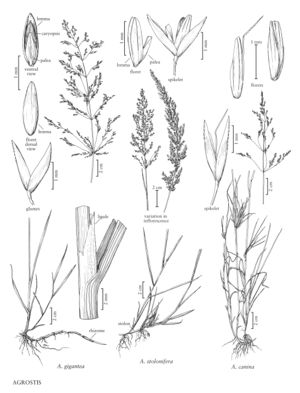Difference between revisions of "Agrostis gigantea"
FNA>Volume Importer |
FNA>Volume Importer |
(No difference)
| |
Revision as of 21:22, 16 December 2019
Plants perennial; rhizomatous, rhizomes to 25 cm, not stoloniferous. Culms 20-120 cm, erect, sometimes geniculate at the base, sometimes rooting at the lower nodes, with 4-7 nodes. Leaves mostly cauline, sheaths smooth or sparsely scabridulous; ligules longer than wide, dorsal surfaces usually scabrous, sometimes smooth, apices rounded to truncate, erose to lacerate, basal ligules 1-4.5 mm, upper ligules 2-7 mm; blades 4-10 cm long, 3-8 mm wide, flat. Panicles 8-25(30) cm long, less than 1/2 the length of the culm, (1.5)3-15 cm wide, erect, open, broadly ovate, exserted from the upper sheaths at maturity, lowest node with (1)3-8 branches; branches scabrous, spreading during and after anthesis, usually some branches spikelet-bearing to the base, lower branches 4-9 cm, usually with many shorter secondary branches resulting in crowding of the spikelets, spikelets restricted to the distal 1/2 of the branches and not crowded in shade plants; pedicels 0.3-3.4(4.2) mm. Spikelets narrowly ovate to lance¬olate, green and slightly to strongly suffused with purple. Glumes subequal, 1.7-3.2 mm, lanceolate, 1-veined, acute to apiculate; lower glumes scabrous on the distal 1/2 of the midvein; upper glumes scabridulous on the distal 1/2 of the midvein; callus hairs to 0.5 mm, sparse; lemmas 1.5-2.2 mm, opaque to translucent, smooth, 3-5-veined, veins usually obscure, sometimes prominent throughout or distally, often excurrent to 0.2 mm, apices usually acute, sometimes obtuse or truncate, usually unawned, rarely with a 0.4-1.5(3) mm straight awn arising from near the apices to near the base; paleas 0.7-1.4 mm, about Vi the length of the lemmas, veins visible; anthers 3, 1-1.4 mm. Caryopses 1-1.5 mm; endosperm solid. 2n = 42.
Distribution
Conn., N.J., N.Y., Wash., Del., D.C, Wis., W.Va., Mass., Maine, N.H., R.I., Vt., Wyo., N.Mex., Tex., La., N.Dak., Nebr., Tenn., Pa., Okla., Alaska, Nev., Va., Colo., Calif., Ala., Ark., Ill., Ga., Ind., Iowa, Ariz., Idaho, Md., Ohio, Utah, Mo., Minn., Mich., Kans., Mont., Miss., S.C., Ky., Oreg., Alta., B.C., Greenland, Man., N.B., Nfld. And Labr. (Labr.), N.S., N.W.T., Ont., P.E.I., Que., Sask., Yukon
Discussion
Agrostis gigantea grows in fields, roadsides, ditches, and other disturbed habitats, mostly at lower elevations. It is a serious agricultural weed, as well as a valuable soil stabilizer. In the Flora region, its range extends from the subarctic to Mexico; it is considered to be native to Eurasia. It is more heat tolerant than most species of Agrostis.
Agrostis gigantea has been confused with A. stolonifera (see next), from which it differs in having rhizomes and a more open panicle. Agrostis stolonifera has elongated leafy stolons, mainly all above the surface, that root at the nodes, and the panicles are condensed and often less strongly pigmented than in A. gigantea. Its distribution tends to be more northern and coastal where ditches and pond margins are common habitats, and its stolons enable it to form loose mats. Agrostis gigantea is ecologically adapted to a more extreme climate—hot summers/cold winters and drought—than A. stolonifera. It is also similar to A. capillaris (p. 639) and A. castellana (p. 639); it differs from both in its longer ligules, from A. capillaris in its less open panicles with spikelets near the base of the branches, and from A. castellana in being more extensively rhizomatous.
When Agrostis gigantea grows in damp hollows under trees it becomes more like A. stolonifera, particularly when the inflorescence is young, not expanded, and pale. If the rootstock is not collected, identification is a major problem.
Selected References
None.
